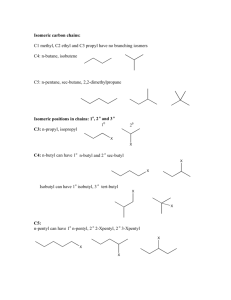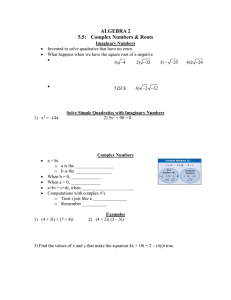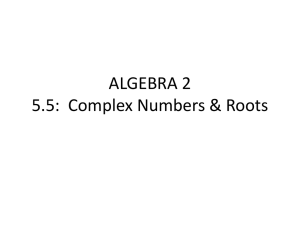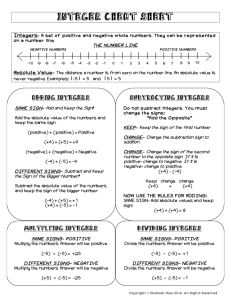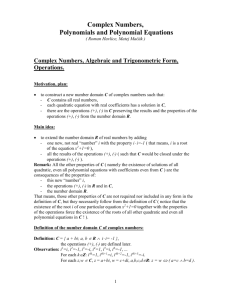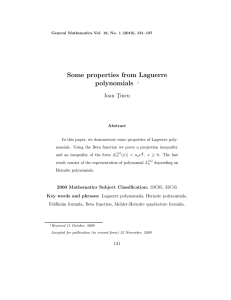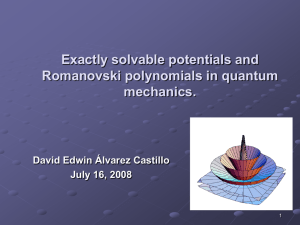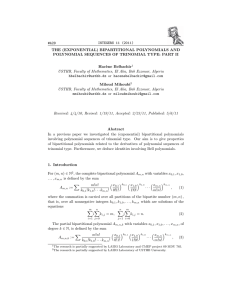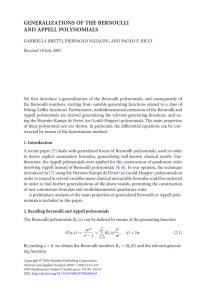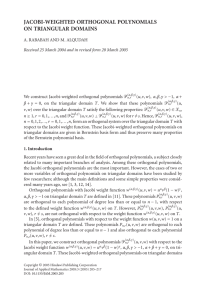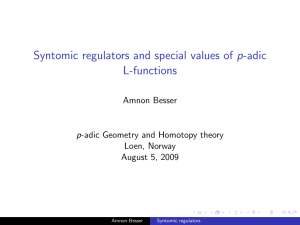Document 10816926
advertisement
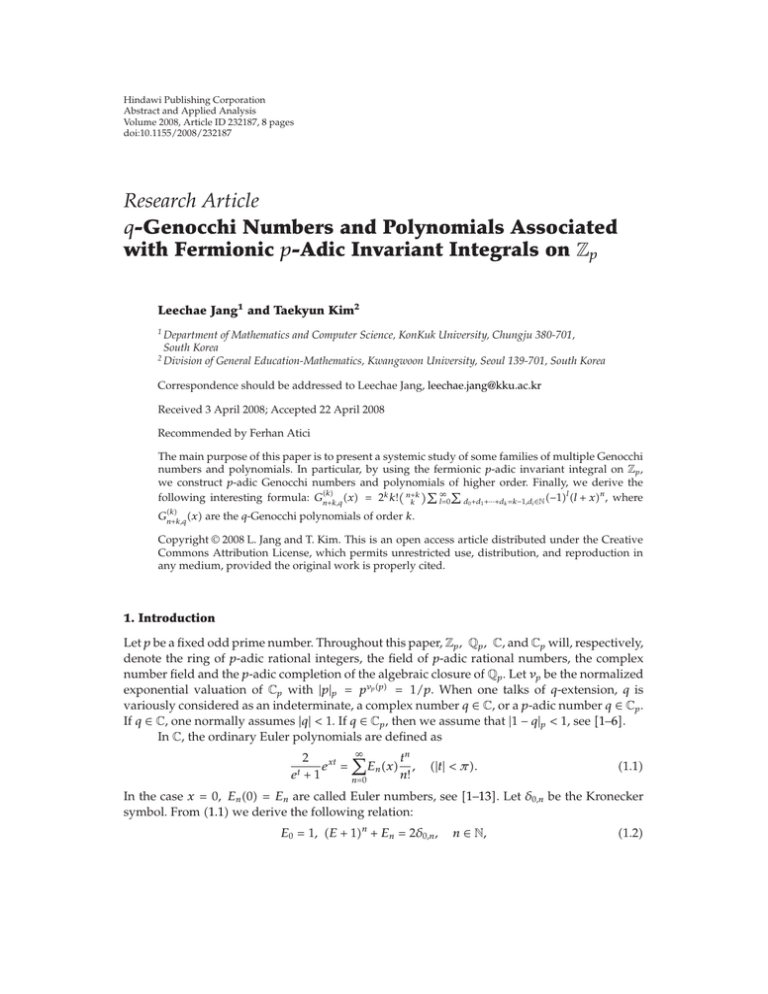
Hindawi Publishing Corporation
Abstract and Applied Analysis
Volume 2008, Article ID 232187, 8 pages
doi:10.1155/2008/232187
Research Article
q-Genocchi Numbers and Polynomials Associated
with Fermionic p-Adic Invariant Integrals on Zp
Leechae Jang1 and Taekyun Kim2
1
Department of Mathematics and Computer Science, KonKuk University, Chungju 380-701,
South Korea
2
Division of General Education-Mathematics, Kwangwoon University, Seoul 139-701, South Korea
Correspondence should be addressed to Leechae Jang, leechae.jang@kku.ac.kr
Received 3 April 2008; Accepted 22 April 2008
Recommended by Ferhan Atici
The main purpose of this paper is to present a systemic study of some families of multiple Genocchi
numbers and polynomials. In particular, by using the fermionic p-adic invariant integral on Zp ,
we construct p-adic Genocchi numbers and polynomials of higher order. Finally, we derive the
∞ k
l
n
following interesting formula: Gnk,q x 2k k! nk
d0 d1 ···dk k−1,di ∈N −1 l x , where
l0
k
k
Gnk,q x are the q-Genocchi polynomials of order k.
Copyright q 2008 L. Jang and T. Kim. This is an open access article distributed under the Creative
Commons Attribution License, which permits unrestricted use, distribution, and reproduction in
any medium, provided the original work is properly cited.
1. Introduction
Let p be a fixed odd prime number. Throughout this paper, Zp , Qp , C, and Cp will, respectively,
denote the ring of p-adic rational integers, the field of p-adic rational numbers, the complex
number field and the p-adic completion of the algebraic closure of Qp . Let νp be the normalized
exponential valuation of Cp with |p|p pνp p 1/p. When one talks of q-extension, q is
variously considered as an indeterminate, a complex number q ∈ C, or a p-adic number q ∈ Cp .
If q ∈ C, one normally assumes |q| < 1. If q ∈ Cp , then we assume that |1 − q|p < 1, see 1–6.
In C, the ordinary Euler polynomials are defined as
∞
2
tn
xt
E
x
, |t| < π.
1.1
e
n
n!
et 1
n0
In the case x 0, En 0 En are called Euler numbers, see 1–13. Let δ0,n be the Kronecker
symbol. From 1.1 we derive the following relation:
E0 1, E 1n En 2δ0,n ,
n ∈ N,
1.2
2
Abstract and Applied Analysis
cf. 7–13. Here, we use the technique method notation by replacing En by En n ≥ 0,
symbolically. The first few are 1, −1/2, 0, 1/4, . . . , and E2k 0 for k 1, 2, . . . . A sequence
consisting of the Genocchi numbers Gn satisfies the following relations:
∞
2t
tn
,
G
n
et 1 n0 n!
|t| < π,
1.3
see 11, 12. It satisfies G1 1, G3 G5 G7 · · · G2k1 0, k 1, 2, 3, . . . , and even
coefficients are given by
G2n 2 1 − 22n B2n 2nE2n−1 0,
1.4
where Bn is Bernoulli numbers. The first few Genocchi numbers for even integers are
−1, 1, −3, 17, −155, 2073, . . . . The first few prime Genocchi numbers are −3 and 17, which occur
at n 6 and 8. There are no others with n < 105 . We now define the Genocchi polynomials as
follows:
∞
2t xt tn
G
x
,
e
n
n!
et 1
n0
|t| < π.
1.5
Thus, we note that
n
Gl xn−l .
Gn x l
l0
n
1.6
In this paper, we use the following notations: xq 1 − qx /1 − q and x−q 1 −q /1 q. Let UDZp be the space of uniformly differentiable functions on Zp . For f ∈
UDZp , the p-adic q-deformed fermionic integral on Zp is defined as
x
I−q f 1
Zp
fxdμ−q x lim N N→∞ p
q
N
−1
p
fx−qx ,
1.7
x0
see 1–4. The fermionic p-adic invariant integral on Zp can be obtained as q → 1. That is,
I−1 f lim I−q f q→1
Zp
fxdμ−1 x.
1.8
From 1.8, we easily derive the following integral equation related to fermionic invariant padic integral on Zp :
I−1 f1 I−1 f 2f0,
1.9
where f1 x fx 1, see 5.
The purpose of this paper is to present a systemic study of some families of multiple
Genocchi numbers and polynomials by using the fermionic multivariate p-adic invariant
integral on Zp . In addition, we will investigate some interesting identities related to Genocchi
numbers and polynomials.
L. Jang and T. Kim
3
2. Genocchi numbers associated with fermionic p-adic invariant integral on Zp
From 1.9 we can derive
t
t
Zp
Zp
e
ext dμ−1 x xyt
et
∞
tn
2t
Gn ,
1 n0 n!
∞
2t xt tn
e dμ−1 y t
Gn x ,
n!
e 1
n0
where Gn x are Genocchi polynomials. It is easy to check that
∞
n
tn
2t
1
n
2x1t
l
e
dμ−1 x t
t sech t t
2 Gl
.
−t
2 n0 l0 l
n!
e e
Zp
By comparing the coefficient on both sides in 2.1, we easily see that
Gn1 x
x yn dμ−1 x .
n1
Zp
2.1
2.2
2.3
Therefore, we obtain the following proposition.
Proposition 2.1. For k ∈ Z ,
i Zp x yn dμ−1 x Gn1 x/n 1 (Witt’s formula for Genocchi polynomials);
n1 l
ii Zp e2x1t dμ−1 x 1/n 11/2 n1
2 Gl , where nl nn − 1 · · · n − l l0
l
1/l!.
Let ϑCp {x ∈ Cp | |x|p ≤ 1} be the integer ring of Cp . We note that i −11/2 ∈ ϑCp . By
using Taylor expansion, we see that
eix ∞
∞
∞
xn −1n x2n
−1n x2n1
in
i
.
n! n0 2n!
2n 1!
n0
n0
2.4
In the p-adic number field, sin x and cos x are defined as
sin x x x3 x5 x7
−
−
··· ,
1! 3! 5! 7!
x2 x4 x6
−
··· .
cos x 1 −
2! 4! 6!
2.5
From 2.4 and 2.5, we derive
eix cos x i sin x.
2.6
This is equivalent to
cos x eix e−ix
,
2
sin x eix − e−ix
.
2i
2.7
4
Abstract and Applied Analysis
By 2.7, we easily see that
sec t 2
it
e e−it
It is not difficult to show that
note that
sec t ∞
in
Zp
n0
Zp
Zp
e2x1it dμ−1 x ∞ Zp
n0
2x 1n dμ−1 x
in tn
.
n!
2.8
2x 12n1 dμ−1 x 0 for n ∈ Z N ∪ {0}. From 2.8, we
2x 1n dμ−1 x
∞
tn −1n
n! n0
Zp
2x 12n dμ−1 x
t2n
.
2n!
2.9
Thus, we have
∞
1
t sec t −1n
2 n0
2n1
l0
t2n1
2n 1
l
2 Gl
.
l
2n 1!
2.10
Now we consider the fermionic multivariate p-adic invariant integral on Zp as follows:
tk
Zp
···
Zp
∞
n
tk
k t
Gn
,
t
n!
e 1 ··· e 1
n0
ex1 x2 ···xk t dμ−1 x1 · · · dμ−1 xk 2k t
2.11
k-times
k-times
k
where Gn are the nth Genocchi number of order k. By comparing the coefficient on both sides
k
k
k
in 2.11, we see that G0 G1 · · · Gn 0, and
Zp
···
Zp
n
k
x1 x2 · · · xk dμ−1 x1 · · · dμ−1 xk n kk Gnk ,
2.12
k-times
where n kk is the Jordan factor which is defined by n kk n k · · · n 1. Thus, we
note that
k
G
n
x1 x2 · · · xk dμ−1 x1 · · · dμ−1 xk nknk
,
n!
Zp
Zp
n
···
2.13
k-times
for k ∈ N, n ∈ Z .
Theorem 2.2. For n ∈ Z , k ∈ N,
k
G
n
x1 x2 · · · xk dμ−1 x1 · · · dμ−1 xk nknk
.
n!
Zp
Zp
n
···
k-times
2.14
L. Jang and T. Kim
5
The multinomial coefficient is well known as
n
n
x1 x2 · · · xk x1l1 x2l2 · · · xklk .
l
,
.
.
.
,
l
1
k
l ···l n
1
2.15
k
l1 ,...,lk >0
Therefore, we obtain the following corollary.
Corollary 2.3. For n ∈ Z , k ∈ N,
l1 ···lk n
n
l1 , . . . , l k
Gl1 1
l1 1
Gl2 1
l2 1
···
Glk 1
lk 1
k
G
nknk
.
n!
n
2.16
l1 ,...,lk >0
For q ∈ Cp with |1 − q| < 1, it is not difficult to show that
t
Zp
qx ext dμ−1 x 2t
.
qet 1
2.17
Now, we define the q-extension of the Genocchi numbers as follows:
∞
tn
2t
G
.
n,q
n!
qet 1 n0
2.18
By 2.17 and 2.18, we easily see that
Gn1,q
n1
Zp
qx xn dμ−1 x.
2.19
With the same motivation to construct the Genocchi polynomials of higher order, we can
consider the q-extension of higher-order Genocchi numbers as follows:
k
t
···
qx2 2x3 ···k−1xk exx1 x2 ···xk t dμ−1 x1 · · · dμ−1 xk Zp
Zp
k-times
∞
n
tk 2k
k t
xt
t
Gn,q ,
t
k−1 t
e n!
e 1 qe 1 · · · q e 1
n0
2.20
k-times
k
where Gn,q are the q-Genocchi polynomials of order k. The basic q-natural numbers are defined
as
nq 1 − qn
1 q q2 · · · qn−1 ,
1−q
n ∈ N.
2.21
The q-factorial of n is defined as
nq ! nq n − 1q · · · 2q 1q 1 q · · · qn−1 · · · 1 q · 1.
2.22
6
Abstract and Applied Analysis
The q-binomial coefficient is also defined as
nq !
nq n − 1q · · · n − k 1q
n
.
k
n − kq !kq !
kq !
2.23
q
Note that limq→1 nk q nk nn − 1 · · · n − k 1/k!. The q-binomial coefficient satisfies
the following recurrsion formula:
n
n
n
n1
k n
n−k
q
q
.
2.24
k−1
k
k
k−1
k
q
q
q
From this recurrsion formula, we can derive
n
k
d d ···d
q
0
1
d i ∈N
q
q
q0·d0 1·d1 ···k·dk .
2.25
k k−1
The q-binomial expansion is given by
n
n
k
n
i−1
q 2 an−k bk ,
a bq
k
i1
k0
q
n
1 − bq
i−1 −1
i1
∞
nk−1
k
k0
2.26
k
b .
q
By 2.20 and 2.26, we see that
···
qx2 2x3 ···k−1xk exx1 x2 ···xk t dμ−1 x1 · · · dμ−1 xk
tk
Zp
Zp
k-times
tk 2k
k
−1
1 − − qi−1 et ext
i1
tk 2k
∞
kl−1
l0
t
k
∞
n0
2
k
2.27
−1l elxt
l
q
∞
kl−1
l
l0
l
−1 l x
q
n
tn
.
n!
Therefore, we obtain the following theorem.
Theorem 2.4. For n ∈ Z , k ∈ N, we have
n
···
qx2 2x3 ···k−1xk x1 x2 · · · xk dμ−1 x1 · · · dμ−1 xk
Zp
Zp
k-times
kl−1
k
2
−1l l xn .
l
l0
∞
q
2.28
L. Jang and T. Kim
7
By 2.20, it is not difficult to show that
k
Gnk,q x
k
nk
k!
···
qx2 2x3 ···k−1xk × x x1 x2 · · · xk
k
Zp
Zp
2.29
k-times
× dμ−1 x1 · · · dμ−1 xk n kk ,
k
k
k
G0,q G1,q · · · Gn,q 0,
where n 0, 1, 2, . . . . Therefore, we obtain the following corollary.
Corollary 2.5. For n ∈ Z , k ∈ N,
k
∞
Gnk,q x
kl−1
k
−1l l xn .
nk 2
l
k! k
l0
q
2.30
Corollary 2.6. For n ∈ Z , k ∈ N,
k
Gnk,q x
∞
nk 2 k!
k
l0 d d ···d
k
0
1
d i ∈N
q0·d0 1·d1 ···k·dk −1l l xn .
2.31
k k−1
Acknowledgment
The present research has been conducted by the research grant of Kwangwoon University in
2008.
References
1 T. Kim, “q-Euler numbers and polynomials associated with p-adic q-integrals,” Journal of Nonlinear
Mathematical Physics, vol. 14, no. 1, pp. 15–27, 2007.
2 T. Kim, “q-Bernoulli numbers and polynomials associated with Gaussian binomial coefficients,”
Russian Journal Mathematical Physics, vol. 15, no. 1, pp. 51–57, 2008.
3 T. Kim, “q-Bernoulli numbers associated with q-stirling numbers,” Advances in Difference Equations,
vol. 2008, Article ID 743295, 10 pages, 2008.
4 T. Kim, “The modified q-Euler numbers and polynomials,” Advanced Studies in Contemporary
Mathematics, vol. 16, pp. 161–170, 2008.
5 T. Kim, “Euler numbers and polynomials associated with zeta functions,” Abstract and Applied
Analysis, vol. 2008, Article ID 581582, 13 pages, 2008.
6 T. Ernst, “Examples of a q-umbral calculus,” Advanced Studies in Contemporary Mathematics, vol. 16, no.
1, pp. 1–22, 2008.
7 H. Ozden, I. N. Cangul, and Y. Simsek, “Multivariate interpolation functions of higher order q-Euler
numbers and their applications,” Abstract and Applied Analysis, vol. 2008, Article ID 390857, 16 pages,
2008.
8 H. Ozden, Y. Simsek, S.-H. Rim, and I. N. Cangul, “A note on p-adic q-Euler measure,” Advanced
Studies in Contemporary Mathematics, vol. 14, no. 2, pp. 233–239, 2007.
9 H. Ozden, I. N. Cangul, and Y. Simsek, “Remarks on sum of products of h, q-twisted Euler
polynomials and numbers,” Journal of Inequalities and Applications, vol. 2008, Article ID 816129, 8 pages,
2008.
8
Abstract and Applied Analysis
10 Y. Simsek, V. Kurt, and D. Kim, “New approach to the complete sum of products of the twisted h, qBernoulli numbers and polynomials,” Journal of Nonlinear Mathematical Physics, vol. 14, no. 1, pp. 44–
56, 2007.
11 M. Cenkci, M. Can, and V. Kurt, “q-extensions of Genocchi numbers,” Journal of the Korean Mathematical
Society, vol. 43, no. 1, pp. 183–198, 2006.
12 M. Cenkci, Y. Simsek, and V. Kurt, “Further remarks on multiple p-adic q-L-function of two variables,”
Advanced Studies in Contemporary Mathematics, vol. 14, no. 1, pp. 49–68, 2007.
13 T. Machide, “Sums of products of Kronecker’s double series,” Journal of Number Theory, vol. 128, no.
4, pp. 820–834, 2008.
